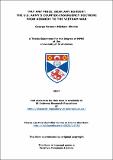Files in this item
'Pay any price, bear any burden': The U.S. Army's Counter-Insurgency Doctrine from Kennedy to the Vietnam War
Item metadata
| dc.contributor.advisor | De Groot, Gerard J. | |
| dc.contributor.author | Ritchie, George Forman Michael | |
| dc.coverage.spatial | vi, 161 p. | en_US |
| dc.date.accessioned | 2017-09-25T13:21:25Z | |
| dc.date.available | 2017-09-25T13:21:25Z | |
| dc.date.issued | 2017-12-08 | |
| dc.identifier.uri | https://hdl.handle.net/10023/11738 | |
| dc.description.abstract | This thesis is an analysis of the U.S. Army’s counter-insurgency doctrine from its roots to its application in South Vietnam during the Vietnam War. Contrary to the arguments of a specific section of scholars, the Army did not fail to defeat the National Liberation Front (NLF) because it did not use counter-insurgency methods. This thesis explains that the Army developed a comprehensive, albeit flawed, counter-insurgency doctrine and applied it in South Vietnam. While the Army’s counter-insurgency doctrine had serious deficiencies, it was the deeply unsound South Vietnamese government and the NLF’s formidable political revolution that were the primary reasons for its failure to achieve its objectives. This thesis utilises the body of literature produced by U.S. Army officers, officers of allied nations and academics during the creation of the Army’s counter-insurgency doctrine, as well as the field manuals that resulted from this research. These sources reveal the self-interest of Army commanders in their pursuit of a counter-insurgency mission, the purpose of which was to reverse the reductions enforced upon the Army during the 1950s. Crucially, these sources also display the Army’s perception of insurgencies in the developing world as the result of Communist-bloc attempts to expand communism. This perception, as well as the overconfidence of much of the Army’s leadership, was influential in shaping counter-insurgency doctrine. The Army’s self-interest put it on a path of its own making that led to the Vietnam War. The Army’s field manuals on counter-insurgency warfare show it expected to face an insurgency that was born out of the Cold War struggle and its methods reflected this belief. Therefore, it did not grasp that the NLF’s revolution had deep-seated historical roots. The Army’s counter-insurgency programmes, which emphasised civic action and destruction of guerrillas, were wholly ineffective in eradicating the NLF’s largely political revolution. | en_US |
| dc.language.iso | en | en_US |
| dc.publisher | University of St Andrews | |
| dc.rights | Attribution-NonCommercial-NoDerivatives 4.0 International | * |
| dc.rights.uri | http://creativecommons.org/licenses/by-nc-nd/4.0/ | * |
| dc.subject | Vietnam War | en_US |
| dc.subject | U.S. Army | en_US |
| dc.subject | Counterinsurgency | en_US |
| dc.subject | Insurgency | en_US |
| dc.subject | Viet Cong | en_US |
| dc.subject | National Liberation Front | en_US |
| dc.subject | South Vietnam | en_US |
| dc.subject | ARVN | en_US |
| dc.subject | COIN | en_US |
| dc.subject | Cold War | en_US |
| dc.subject | Wars of national liberation | en_US |
| dc.subject.lcc | U241.R58 | |
| dc.subject.lcsh | Counterinsurgency--United States | en |
| dc.subject.lcsh | United States--Armed Forces--History--20th century | en |
| dc.subject.lcsh | United States--Foreign relations--20th century | en |
| dc.title | 'Pay any price, bear any burden': The U.S. Army's Counter-Insurgency Doctrine from Kennedy to the Vietnam War | en_US |
| dc.type | Thesis | en_US |
| dc.type.qualificationlevel | Doctoral | en_US |
| dc.type.qualificationname | MPhil Master of Philosophy | en_US |
| dc.publisher.institution | The University of St Andrews | en_US |
The following licence files are associated with this item:
This item appears in the following Collection(s)
Except where otherwise noted within the work, this item's licence for re-use is described as Attribution-NonCommercial-NoDerivatives 4.0 International
Items in the St Andrews Research Repository are protected by copyright, with all rights reserved, unless otherwise indicated.


